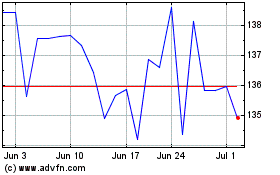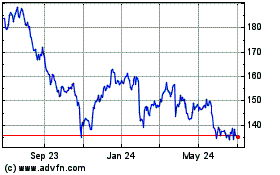By Paul Ziobro
United Parcel Service Inc. will for the first time charge
retailers extra fees to deliver packages during the busiest weeks
before Christmas, creating a new challenge for an industry already
coping with a shift away from traditional stores.
The surcharges, announced Monday, are a shot across the bow for
retailers, including giants such as Wal-Mart Stores Inc. and Macy's
Inc., that have been ramping up their e-commerce businesses as they
seek to offset declining foot traffic to shopping centers. It also
adds to the costs of Amazon.com Inc. and other online players,
which rely on UPS and rival FedEx Corp. to handle a surge in
holiday shipments.
The fees will force retailers to decide over the next few months
whether to raise shipping prices -- something that is difficult to
do when online shoppers are reluctant to pay shipping fees --
increase the prices of goods or eat the extra costs themselves.
Some may seek to avoid the surcharges by spreading holiday deals to
other weeks during the season.
Patrick Gill, chief executive of the high-end fishing gear site
TackleDirect.com, said news of the surcharge was frustrating since
it is going to be applied when his site needs lower rates to
compete against Amazon.com Inc., Wal-Mart Stores Inc. and
others.
"This will add up to be another unaccounted for expense during
the holiday season," Mr. Gill said. "It will force us to push some
product away from UPS in some cases."
For UPS, the move signifies a need to get paid for a service
that has become an integral cog in the holiday shopping period,
when it must add planes, trucks and thousands of staffers. While
Amazon and countless other websites are the front door to millions
of products on the web, UPS, FedEx and the U.S. Postal Service do
the heavy lifting that eliminates trips to stores and delivers
packages to homes.
UPS is "trying to make sure they are, at the margin, getting
compensated for stretching their network," said Sanford C.
Bernstein analyst David Vernon, adding that the carriers have the
power to raise prices given how critical they have become to the
period. "Without them, Christmas kind of doesn't happen."
Some analysts expect FedEx to follow in some way, as the two
rivals often take pricing cues from each other. A FedEx spokesman
declined to comment. The company reports its fiscal fourth-quarter
earnings Tuesday.
The surcharges unveiled by UPS will hit its customers during the
busiest shipping weeks and on the most popular products during that
time. Between Nov. 19 and Dec. 2 -- the weeks encapsulating Black
Friday and Cyber Monday -- UPS is adding a 27-cent charge on all
ground packages sent to homes. Ground orders typically arrive
within five days and are a heavily used shipping option during that
time since shoppers don't necessarily need the items quickly.
Last year, UPS collected on average $7.97 in revenue per item
shipped in its U.S. ground network.
The peak surcharges won't be in effect for the following two
weeks, when shoppers typically take a pause, but they will return
for the final holiday rush. From Dec. 17-23, UPS will charge an
extra 27 cents for each ground shipment, 81 cents for next-day air
and 97 cents for two- or three-day delivery.
In a twist, the UPS surcharge includes an element that gives
stores an advantage.
The charges apply only to residential deliveries, so retailers
and shoppers may be able to avoid the charges by getting orders
shipped to stores, an option retailers have been pushing for the
past few yearswith varying success.
UPS Chief Commercial Officer Alan Gershenhorn said the
per-package cost will only "marginally increase" during this time.
As an example, UPS said a five-pound next-day air package from
Atlanta to Philadelphia will cost 1% more to ship. Another example
offered by UPS showed a 2% increase with the added fee.
UPS daily volume swells to more than 30 million in the weeks
before Christmas versus more than 19 million on a normal day. Citi
Research estimates the new surcharges will add $50 million in
revenue and profit at UPS this year.
The carrier declined to provide a projection on the revenue
impact from the surcharges, but said it already was factored into
its outlook. The company had more than $60 billion in revenue last
year.
Shippers may try to avoid the surcharge by offering more deals
in October and early November, or by negotiating a discount. "The
real objective for the surcharge is to motivate shippers to do
their part in avoiding such volume increases," said Satish Jindel,
president of ShipMatrix Inc., a software provider that analyzes
shipping data.
UPS, FedEx and the U.S. Postal Service are all looking to recoup
massive investments they are making in their delivery
infrastructure to accommodate the surge of packages flowing into
their networks in recent years as more people shop online.
UPS is spending $4 billion this year alone as it automates more
package-sorting hubs and opens new warehouses.
UPS is looking at other ways to recoup costs during peak
periods, so it isn't left holding the bag for the additional
investments. Last month, UPS CEO David Abney said the carrier is
negotiating with retailers to help them pay for the any additional
investments, even the capacity goes unused.
On Monday, UPS said will also impose surcharges on all large
packages above a certain threshold, which cost more to ship and
sort, throughout the entire period. Those surcharges will be more
onerous, tacking an additional $24 fee to an existing surcharge of
$70 for a package weighing more than 150 pounds and over a certain
size.
UPS also will charge a peak surcharge of $249 per package on the
largest packages, on top of a $150 fee for such "overmax" packages.
A UPS spokesman said that such items only represent a small sliver
of packages, since most are shipped through its freight
business.
The company is encouraging shippers to instead send such
packages through its freight network, where it recently imposed a
second 4.9% increase in shipping rates the past year.
Write to Paul Ziobro at Paul.Ziobro@wsj.com
(END) Dow Jones Newswires
June 19, 2017 18:56 ET (22:56 GMT)
Copyright (c) 2017 Dow Jones & Company, Inc.
United Parcel Service (NYSE:UPS)
Historical Stock Chart
From Mar 2024 to Apr 2024

United Parcel Service (NYSE:UPS)
Historical Stock Chart
From Apr 2023 to Apr 2024
